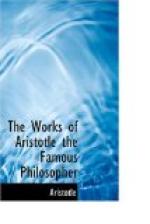The use of the preparing vessels is this; the arteries convey the blood to the testicles; some part of it is absorbed in nourishing them, and in the production of these little bladders (which resemble eggs in every particular), through which the vasa preparantia run, and which are absorbed in them; and the function of the veins is to bring back whatever blood remains from the above mentioned use. The vessels of this kind are much shorter in women than in men, because they are nearer to the testicles; this defect is, however, made good by the many intricate windings to which those vessels are subject; for they divide themselves into two branches of different size in the middle and the larger one passes to the testicles.
The stones in women are very useful, for where they are defective, the work of generation is at an end. For though those bladders which are on the outer surface contain no seed, as the followers of Galen and Hippocrates wrongly believed, yet they contain several eggs, generally twenty in each testicle; one of which being impregnated by the animated part of the man’s seed in the act of copulation, descends through the oviducts into the womb, and thus in due course of time becomes a living child.
* * * * *
CHAPTER XVI
Of the Organs of Generation in Man.
Having given a description of the organs of generation in women, with the anatomy of the fabric of the womb, I shall now, in order to finish the first part of this treatise, describe the organs of generation in men, and how they are fitted for the use for which Nature intended them.
The instrument of generation in men (commonly called the yard, in Latin, penis, from pendo, to hang, because it hangs outside the belly), is an organic part which consists of skin, tendons, veins, arteries, sinews and great ligaments; and is long and round, and on the upper side flattish, seated under the os pubis, and ordained by Nature partly for the evacuation of urine, and partly for conveying the seed into the womb; for which purpose it is full of small pores, through which the seed passes into it, through the vesicula seminalis,[4] and discharges the urine when they make water; besides the common parts, viz., the two nervous bodies, the septum, the urethra, the glans, four muscles and the vessels. The nervous bodies (so called) are surrounded with a thick white, penetrable membrane, but their inner substance is spongy, and consists chiefly of veins, arteries, and nervous fibres, interwoven like a net. And when the nerves are filled with animal vigour and the arteries with hot, eager blood, the penis becomes distended and erect; also the neck of the vesicula urinalis,[5] but when the influx of blood ceases, and when it is absorbed by the veins, the penis becomes limp and flabby. Below those nervous bodies is




